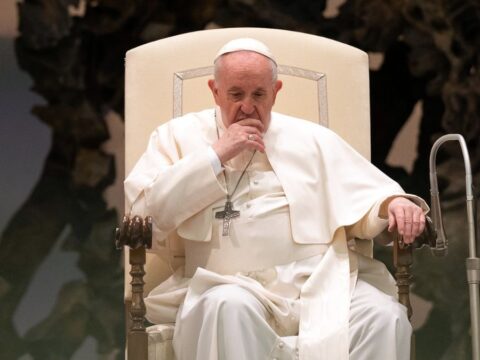Johnessco Rodriguez loves an adrenaline rush. Skydiving, motorcycle racing, double diamond-level downhill skiing — he’s tried it all. He oversees a contemporary art fair in Monaco and dreams of more time for himself. “It would be great if my business could run more or less without me someday,” he says.
Andrew Horwood loves classical composers. “Some people see a therapist when they’re feeling down, but I listen to music,” he says. “It lifts my mood and regenerates me.” In his spare time, he runs a meet-up group for people interested in attending symphonies or chamber-music concerts together.
You may unsubscribe from any of our newsletters at any time.
The two men have little in common, but they both showed up to an “appreciation walk” along the St. Lawrence River in Montreal last April. The concept was for participants to share what makes them feel happy or grateful while enjoying the springtime weather and city-park scenery. With encouragement from a life coach named Samantha Barley, seniors chatted with millennials, recent immigrants with lifelong residents, and Anglophones with Francophones. Demographics posed no barrier to the conversations because everyone, without exception, is interested in cultivating happiness.
Although the specific sources of happiness vary from person to person, it’s still possible to make generalizations about the factors that can help human beings to thrive. Religion appears to be among them, although the picture is complex. That’s why social scientists have been looking at religion under a statistical microscope, trying to discern which of its components boost happiness and whether these components can be extracted to enrich the lives of non-religious people as well.
Happiness first became an object of empirical academic study by social scientists in the 1960s. At the time, it wasn’t always taken seriously. “It always puzzled me that psychologists believed that depression and anxiety were measurable, but that positive states were not,” recalled the happiness-research pioneer Ed Diener in his autobiography. “Because several high-status professors in my department [at the University of Illinois] thought that studying happiness was a flaky endeavour, they blocked my promotion to full professor for a year or two.” Today, by contrast, there are entire academic journals devoted to the subject, bearing such titles as Journal of Happiness Studies and Psychology of Well-Being. Harvard University just launched a $21-million Center for Health and Happiness.
For clarity’s sake, researchers break down happiness into subcategories. “Affect” refers to whatever emotions a person might be experiencing at a given time, and “positive affect” is a pleasurable feeling, perhaps the result of eating a tasty meal or receiving a compliment. The daily ups and downs of a person’s affect can be contrasted with his or her “life satisfaction,” also known as “evaluative happiness.” This is measured by asking subjects to rate their lives on a scale of, say, one to 10. Someone who happens to be having a miserable day might still rate their life highly, while someone who frequently experiences in-the-moment pleasure might nevertheless suffer from poor overall satisfaction.
The concept of living life in a way that promotes long-term satisfaction and well-being goes all the way back to Aristotle, who used the Greek term eudaimonia to describe it. He believed eudaimonic happiness grows out of behaving in accordance with reason and virtue, and that it is the ultimate goal of human existence. Not everyone agrees, but nobody would deny its appeal. “We all want to live happy and fulfilling lives, and we want the people we love to be happy too,” argues Action for Happiness, a British NGO focused on promoting happiness and the conditions that enable it. “It is self-evidently desirable. Our overall happiness — how we feel about our lives — is what matters to us most.”
Religious people of all stripes report feeling happier than their non-religious counterparts.
What’s religion got to do with it?
Happiness isn’t typically an explicit, central focus of the major world religions. Yet, on average, religious people of all stripes (Christians, Muslims, religious Jews, Buddhists, Sikhs and so on) report feeling happier than their non-religious counterparts, whether happiness is defined as affect or life satisfaction. Meta-analyses use hundreds of surveys and studies from around the world, dating from between the 1930s and the present day, that provide peer-reviewed evidence for this correlation. Some of the more recent evidence is from the British Annual Population Survey. An official government report on its 2011/2012 data found that “other things being equal, respondents who said that they have a religious affiliation rate their levels of ‘happiness yesterday,’ ‘life satisfaction’ and ‘[life] worthwhile’ higher, on average, than people who said they do not have a religious affiliation.”
However, there is a chicken-or-egg question: does religion make people happier or are happier people more likely to take up religion? “Identifying a causal relationship is kind of like the elusive holy grail in social science,” says Chaeyoon Lim, a University of Wisconsin-Madison sociologist with an interest in religion. Researchers can trace causality with more confidence when they can assign their subjects randomly to either a test group or a control group — an experimental gold standard known as a randomized control trial. But it wouldn’t be ethical — or practical — to ask people to join or quit a religion for the sake of a study.
“Still, here in the United States, the correlation is strong and consistent,” says Lim. “That is, people who are religiously involved do tend to report a higher level of life satisfaction, as well as better mental and physical health.”
Timothy Caulfield, a Canada Research Chair in Health Law and Policy and a professor at the University of Alberta, highlights another issue that may be muddying the waters. “People who are religious — do they think they’re supposed to be happy?” he asks. “Maybe they respond to surveys differently because of that.” In particular, certain strains of evangelical Protestantism emphasize joy as the inevitable result of a personal relationship with God. However, it isn’t yet clear whether evangelicals are happier than mainline Protestants. The Pew Center found some evidence in 2006 and in 2010 that white evangelicals are happier than white mainline Protestants, but the difference disappeared once they controlled for frequency of church attendance. Regardless of denomination, those who attend more often are happier.
The meaning of life
Rev. Sheldon LeGrow, a retired United Church minister living in Gander, N.L., has experienced his share of ups and downs in life. He’s been unemployed, “a hair’s breadth away from being homeless.” He spent seven years training for ministry (including his undergrad), getting himself knee-deep in student debt, only be to warned that he might not be suited to ordained ministry. He did become an ordained minister and was later fired from two pastoral charges due to theological differences with the congregations. He’s been divorced — twice. On the plus side, his third wife, Christine, with whom he’s been married for 15 years, is his “strength and joy.”
Through all the trials of life, he says he’s “never doubted that life has meaning. I’ve always felt a connection to something greater than myself, of which I’m a part. You could call it God, although my conception of God might not be the same as somebody else’s. . . . When I look back over the years, I can see that with each thing that happened, I was being led in a particular direction,” he says. “I had to have all of those experiences because they led me to happiness. I’m grateful for them.”
A sense of meaning like the one that LeGrow describes — in his case, a sense that events happen for a reason, that there’s an underlying logic to existence and that life is leading somewhere worthwhile — may be one of the mediating factors that help to explain the link between religion and life satisfaction. “As humans, we need to construct explanations about the way the world works,” says University of Toronto psychologist Michael Inzlicht, who uses the term “meaning” to describe a connection between the maps of the world we create in our minds and our actual experiences of the world. According to Inzlicht, part of the anterior cingulate cortex of the human brain is involved in producing a “distress signal” when things don’t make sense to us, when we don’t know how to behave or when we’re exposed to a lot of uncertainty.
Religion can provide more robust explanations of the world and its events than many other systems of belief can, Inzlicht argued along with two co-authors in a 2011 academic paper titled “The Need to Believe: A Neuroscience Account of Religion as a Motivated Process.” “Take, for example, a person who believes that fairness is a law that governs events — that people generally get what they deserve, good or bad,” they wrote. “This theory might work much of the time. . . . Inevitably, however, this rule will be violated — whether it’s by an infant who suffers a painful illness or a psychopath who wins the lottery. Religious belief, on the other hand, entails that there is an order to the universe that believers are not always able to comprehend, and for this reason even the most inexplicable events become explicable: God works in mysterious ways.”
Statistics support the theory that people who believe in something divine are more likely than others to feel that life is meaningful. The 1998 and 2008 U.S. General Social Survey results revealed that 61 percent of those who claimed to believe in God disagreed strongly with the statement “In my opinion, life does not serve any purpose,” compared with 49 percent of those who did not believe in God or who were unsure. Previously, a 2005 study of American university students “painted a picture of religious persons feeling greater meaning in life as they attend services, meditate or read about spirituality,” wrote psychologist and human well-being researcher Michael Steger and co-author Patricia Frazier. “[Their] sense of meaning is in turn associated with greater positive regard for their lives and selves.”
Gifts that give back
Central United in Moncton, N.B., is an enormous old brick church with stone accents and Gothic windows. It’s attached, via an atrium and indoor meditation garden, to a slick new office tower. Together, the two structures make up the Community Peace Centre, home since 2012 to a variety of non-profit organizations including a multicultural association that helps to settle new immigrants and a health clinic aimed at homeless people without medical cards. It’s a one-stop shop for people using the various services, and it also helps the administrators to save money by sharing conference rooms and event spaces.
“The Peace Centre makes many of us very happy,” says David Lewis, a church council member at Central United. “It was a lot of hard work [to establish it], but it was satisfying. The not-for-profits had vision but little equity. We had equity, and we realized that they knew how to run programming better than the small group of us did. And so, everyone gained something. There’s a lot of good work happening here that makes people happier, and their happiness is contagious.”
The idea that happiness can grow out of generosity and serving others is ancient, but there is new neuroscience to back it up. In 2006, fMRI (functional magnetic resonance imaging) experiments published in Proceedings of the National Academy of Sciences showed that choosing to give money to a good cause appears to activate the brain’s “reward-processing system,” the same network that would respond to gaining something for one’s self.
Statistically, religious Canadians are more likely to be involved with humanitarian organizations compared to non-religious Canadians, according to a 2015 analysis from the University of Victoria. “Religious values and beliefs often stress the importance of equality and looking out for one another,” noted the author, Leila Mazhari.
However, caring comes with a caveat: it doesn’t necessarily increase subjective well-being when it becomes an overwhelming burden, as is sometimes the case, for example, with long-term family caregivers. “There are times when we need to give because it is the compassionate response and the right thing to do,” writes British psychologist Vanessa King for Action for Happiness. As a general rule, though, she advises giving to causes that are aligned with our values and make us feel good. “If we are happy givers, we are more likely to continue to give.”
True belonging
Starting in the 1950s, individual American states began repealing so-called “blue laws” prohibiting Sunday shopping. Unsurprisingly, some people started going to worship services less often. A 2011 paper published in the Journal of Law and Economics examined 10 of these states, which repealed their laws between 1973 and 1998. The study, called “Religious Participation versus Shopping: What Makes People Happier?” found that although men and women both stopped going to church at the same rates, self-reported happiness only declined among women. Did the women end up spending more time in soul-destroying big box stores? The study doesn’t say.
An interesting aspect of this natural, real-world study was that the people who decided to spend more time at the mall and less time at church didn’t necessarily change their inner beliefs and meaning systems; it’s likely that many of them still considered themselves religious or spiritual.
Individual spirituality and organized religion both offer meaning in life, but only the latter involves regular face-to-face gatherings. These may be a part of religion’s advantage when it comes to life satisfaction. Take the Sunday morning service at Central United in Moncton as an example. Last April 10, attendees shared fond memories of parishioners who’d passed away during the previous year. One woman had been a great cook who made molasses cookies and gumdrop cakes every Christmas. One man would always appear to be sleeping at council meetings until he would open his eyes and say something perfectly relevant and brilliant. “Let’s take a moment this morning and light a candle for all of these wonderful people,” said the minister, Rev. Jim MacDonald. “Hopefully, we too may go on and live life in such a way that one day, a group of people might want to remember good stories about our lives — about how we made a community more than it ever could have been without our presence.”
Near the gathering’s end, some of the church people took the mic and told the rest what they were celebrating that week, throwing some change into a jar for the Mission and Service Fund as they did so. One parishioner announced that he was grateful to have survived brain surgery, prompting applause from the whole room. Another participant had enjoyed helping one of her church friends find a prom dress for the friend’s granddaughter. “That’s something I thought I’d never get to do as a mom of two boys,” she said.
The service had begun with the invocation “Let there be joy in our coming together,” and clearly there was happiness to be found within this close-knit congregation.
In Canada, religiosity is strongly associated with social involvement — more than many other factors including employment, a high education level or good health, according to Mazhari. But it isn’t only that church people socialize a lot; the nature of their relationships might be relevant as well. Chaeyoon Lim’s research suggests that on average, friendships within religious congregations increase happiness more than the same number of friendships outside of congregations. “People find social support more meaningful when it comes from someone with a shared sense of social identity. . . . It strengthens a sense of belonging,” he and his co-author wrote in a paper called “Religion, Social Networks, and Life Satisfaction.”
“Furthermore,” they continued, “the sense of community buttressed by close friends within a congregation may also serve as a plausibility structure for other commitments closely attached to religious identity, such as moral values and lifestyle. This could confirm one’s sense that she is making the right choices in her life. . . . [In our findings], only when people have both a sense of religious identity and within-congregation networks does religion lead to greater life satisfaction. . . . Praying together seems to be better than either bowling together or praying alone.” In other words, in a healthy congregation, meaning and social support reinforce each other. (By contrast, Lim also found that people who belonged to a faith community but who didn’t have friends in the congregation were less satisfied than people who didn’t attend religious gatherings at all.)
A 2015 peer-reviewed study of over 9,000 adults in Western Europe asked a different question but came to a similar conclusion. The researchers, based in the Netherlands, were interested in whether social involvement helps to protect people against clinical depression. Subjects were asked about their participation in volunteer work, educational courses, sports, religion and political organizations. Only religious activities were associated with significantly less depression. The conclusion was that “religious organizations may offer mental health benefits beyond those offered by other forms of social participation.”
Despite findings like these, Lim suspects it’s entirely possible to find equally meaningful friendships in secular contexts — perhaps in a group of social activists who feel very strongly about the importance of their work, for example. Caulfield concurs: “I’m not convinced there’s anything magical about religious communities in particular,” he says. “Community is important, though. There’s a lot of evidence that it’s one of the handful of things that are truly relevant to your health and well-being.”
65 percent of the world’s people would answer yes to the question “Is religion an important part of your daily life?” In Canada, around 45 percent of the population feels that way.
The global picture
According to Gallup data, roughly 65 percent of the world’s people would answer yes to the question “Is religion an important part of your daily life?” In Canada, around 45 percent of the population feels that way. Religiosity levels are the lowest (generally less than 30 percent of the population) in prosperous, socialist democracies such as Denmark, Norway, Sweden and the Netherlands. Yet, according to the annual UN-commissioned World Happiness Reports, these nations are also consistently among the happiest in the world. What’s more, in places like Senegal and Bangladesh — countries with the most self-reported religious people (around 98 percent) but where daily survival is a struggle — life-satisfaction scores are near the bottom of the scale.
If religious individuals are happier, why isn’t the same true of countries? Ed Diener tackled this puzzle in a 2011 paper, published in the Journal of Personality and Social Psychology, called “The Religion Paradox: If Religion Makes People Happy, Why are So Many Dropping Out?” He pointed out that when social scientists find that religious individuals are generally more satisfied than their secular counterparts, they do so only after statistically controlling for a whole slew of other relevant variables including income, health, safety, education and so on. A religious Bangladeshi brick-factory worker is likely to be happier than the non-religious Bangladeshi in the hut next door, but chances are that he’s not happier than a secular Swede who enjoys free health care and a steady job in a field that interests her.
By breaking down countries by their levels of development, Diener noticed that religion’s effect on happiness appears much smaller in the world’s richer nations. (The United States is a strange bird that doesn’t conform to this pattern, but it also scores lower than many other rich countries on development indicators such as security from violence, parental leave, access to post-secondary education and income equality.)
“Religion helps people cope with difficult circumstances,” Diener hypothesized, “and therefore is more beneficial when people’s life context is difficult. . . . In economically developed nations, we surmise people are better able to achieve high subjective well-being without the help of organized religion.”
The Nobel Prize-winning Princeton economist Angus Deaton published a similar idea two years later, after taking his own look at the data. “The sharpest puzzle here is why the religiosity advantage for individuals does not carry through to the country averages,” he wrote, along with co-author Arthur A. Stone. “We can only suggest possibilities. One story is that religiosity is a response to a hostile environment. . . . Religion provides a partial refuge, from disease and distress when it can, and a promise of relief in the next world when it cannot. As states gain capacity to provide for the economic and personal security of their citizens, religiosity declines.”
As always when it comes to correlation, it’s also possible that some of the causality goes in the opposite direction: “You could maybe argue that the heavily religious countries are less likely to produce the progressive social policies that foster widespread happiness in the long run,” suggests Caulfield.
Speaking of policy, it’s hard to imagine a government in a democratic society promoting religious involvement for its citizens, muses Lim. “However, maybe that’s why it’s useful to understand the mechanisms; that is, what is it in religion that makes people happy and how those factors can be replicated in non-religious organizations,” he says. “Also, it’s important to recognize that there is more than one path toward happiness.”
This story originally appeared in the July 2016 issue of The UC Observer.















